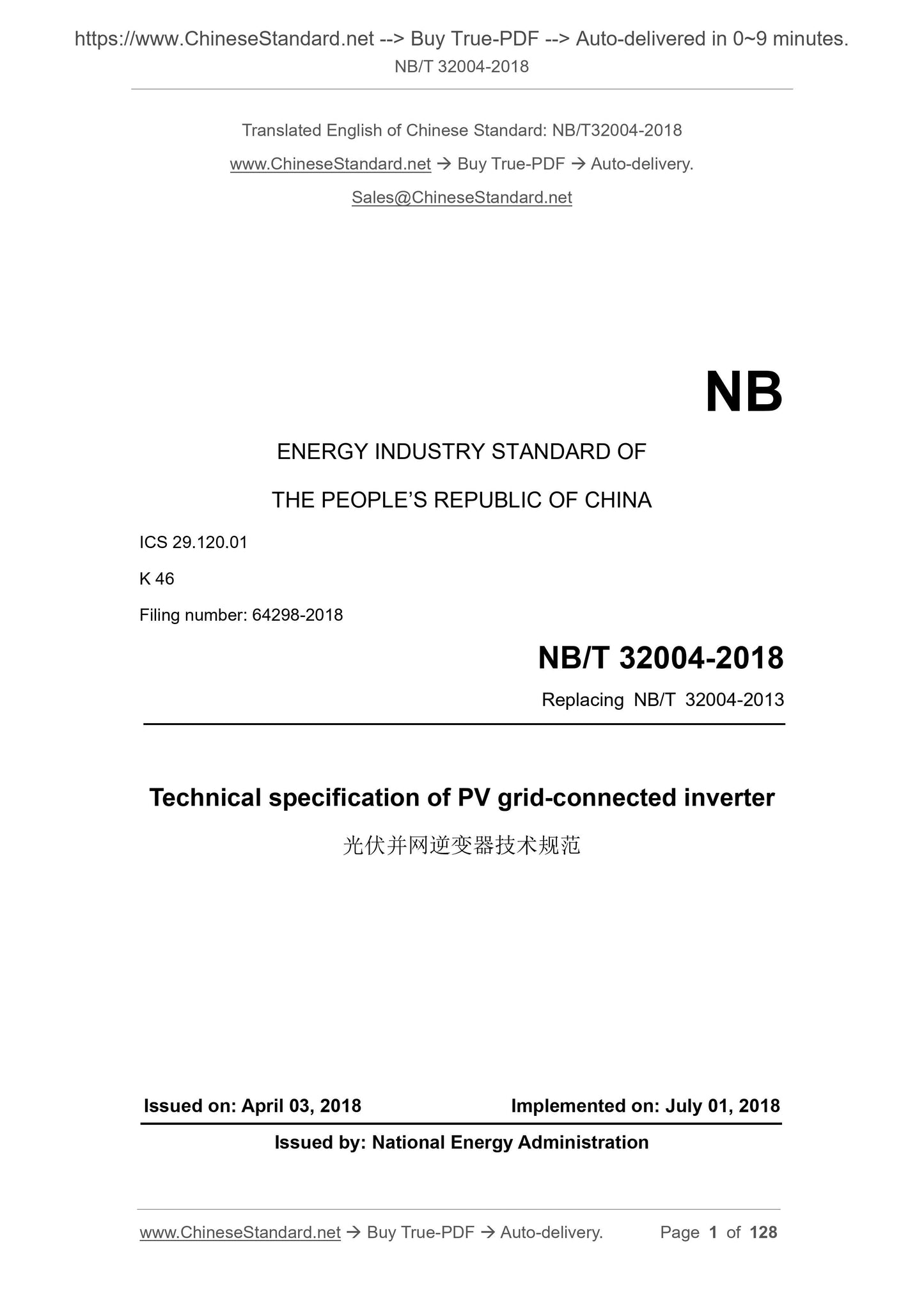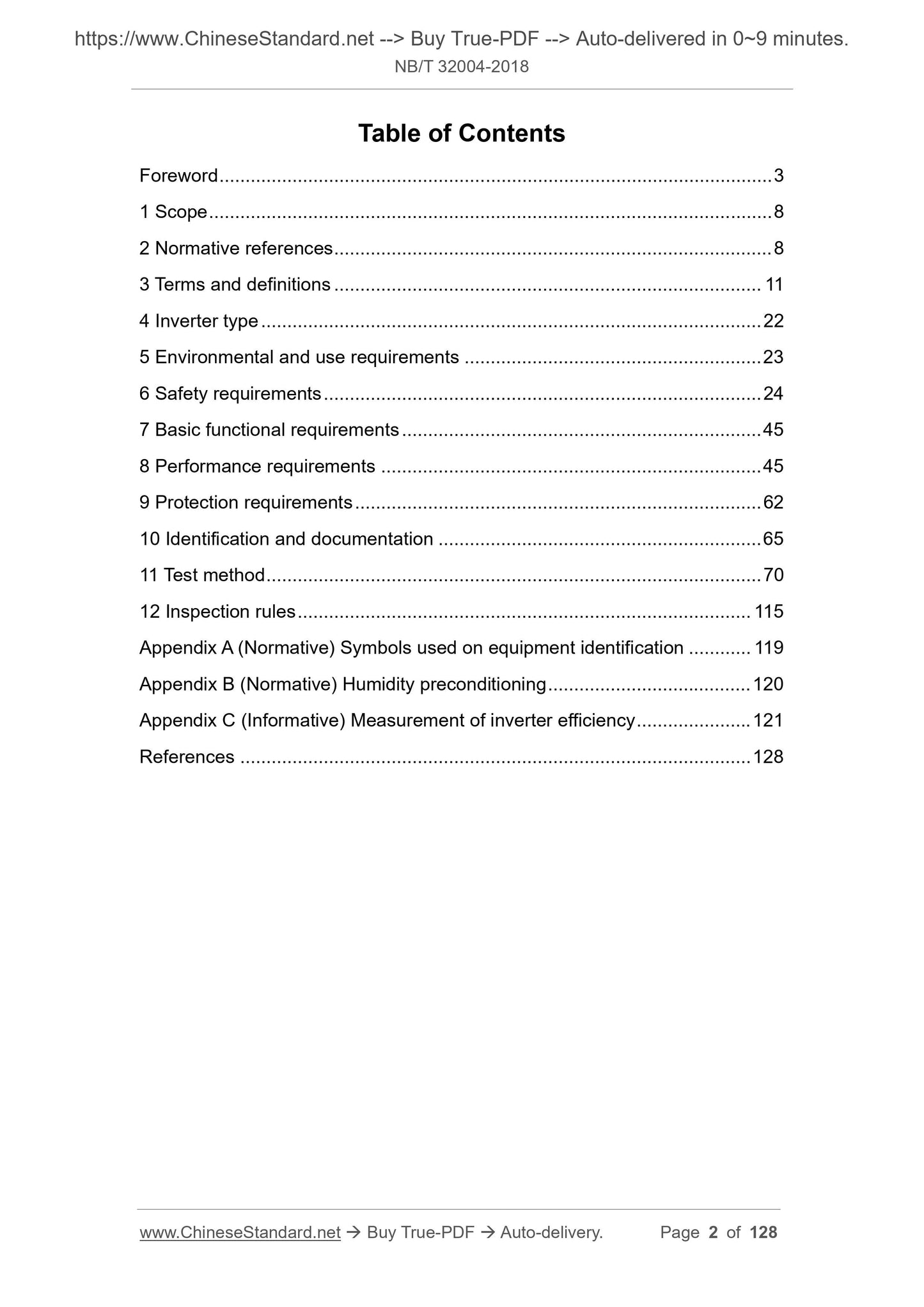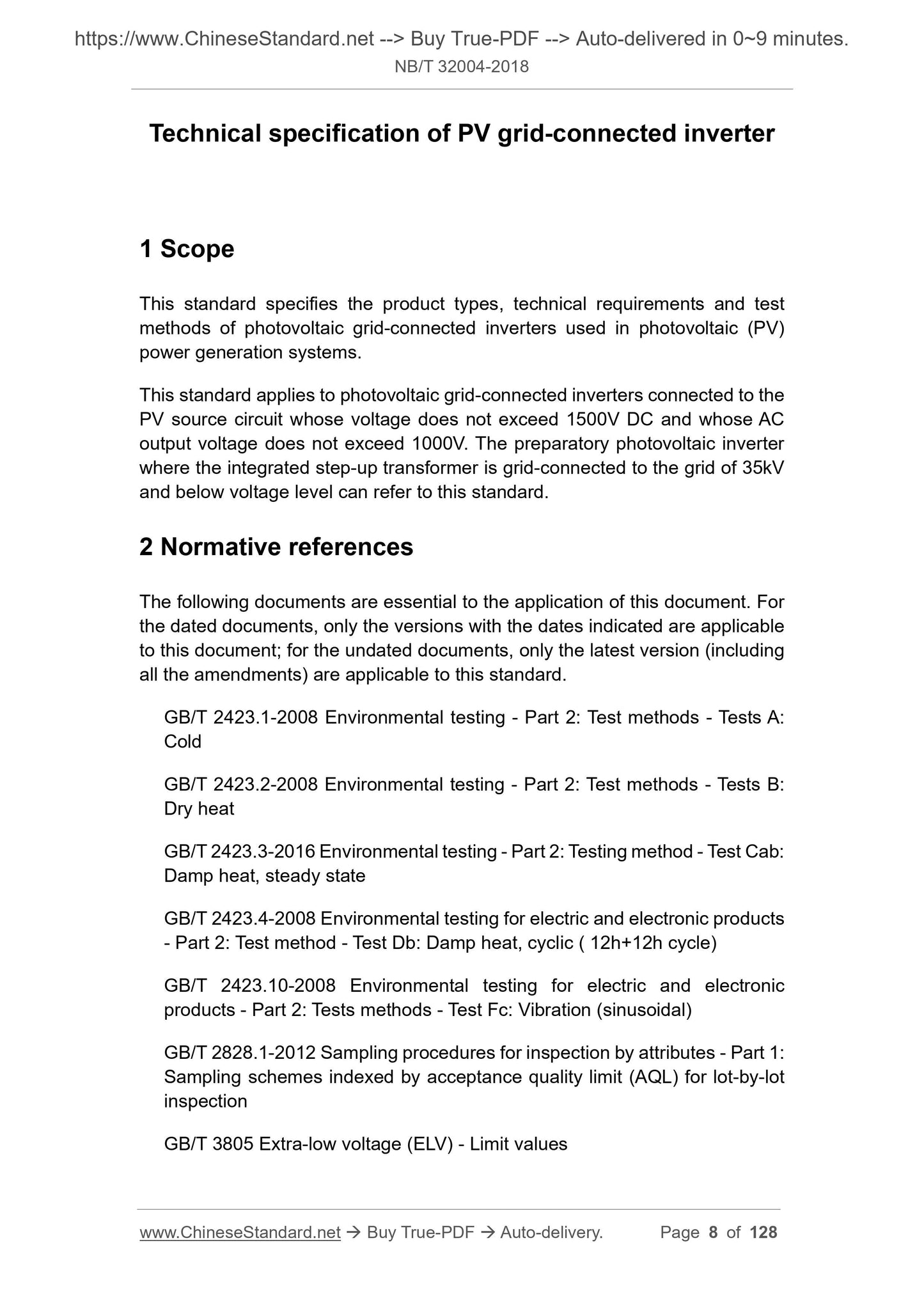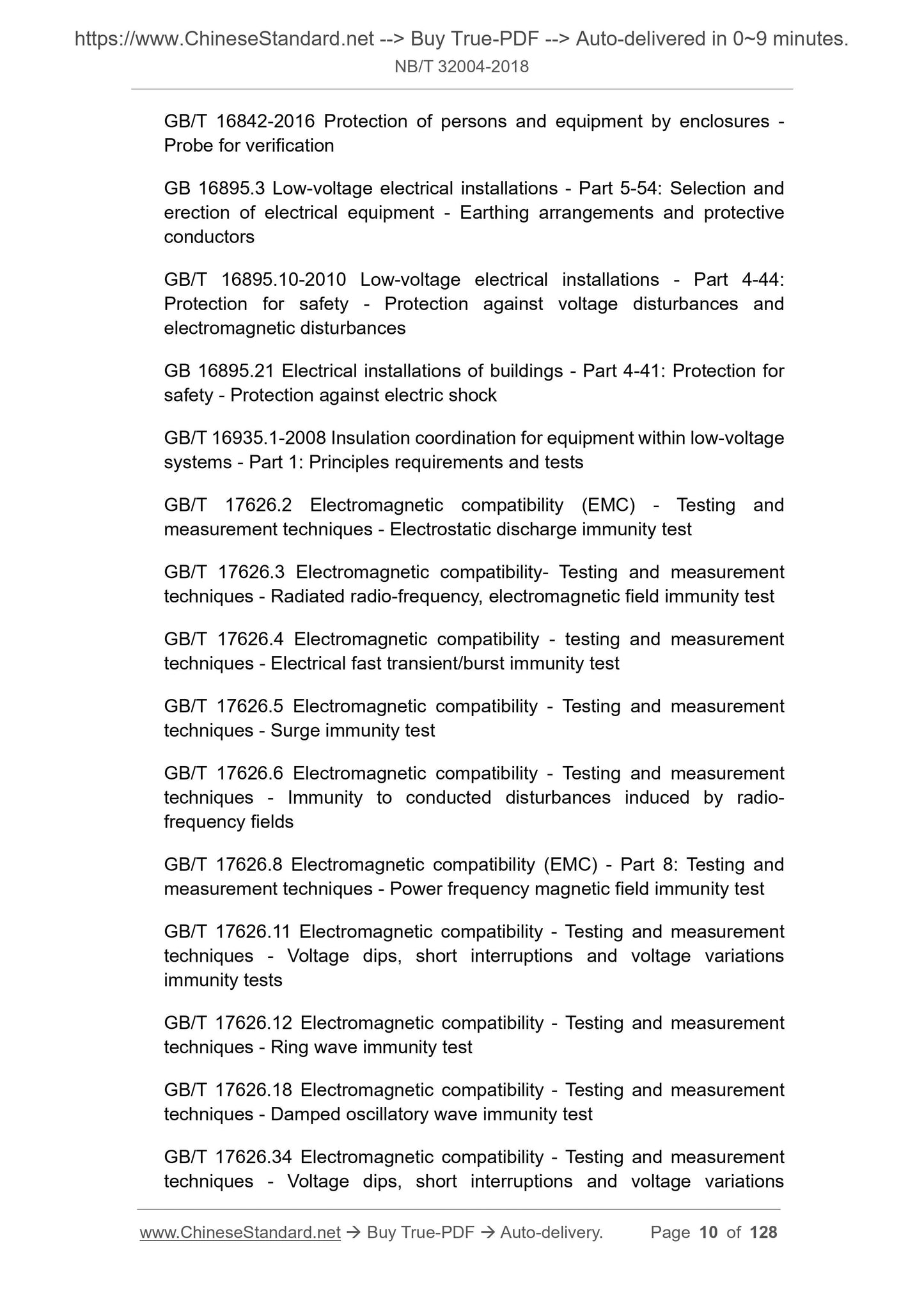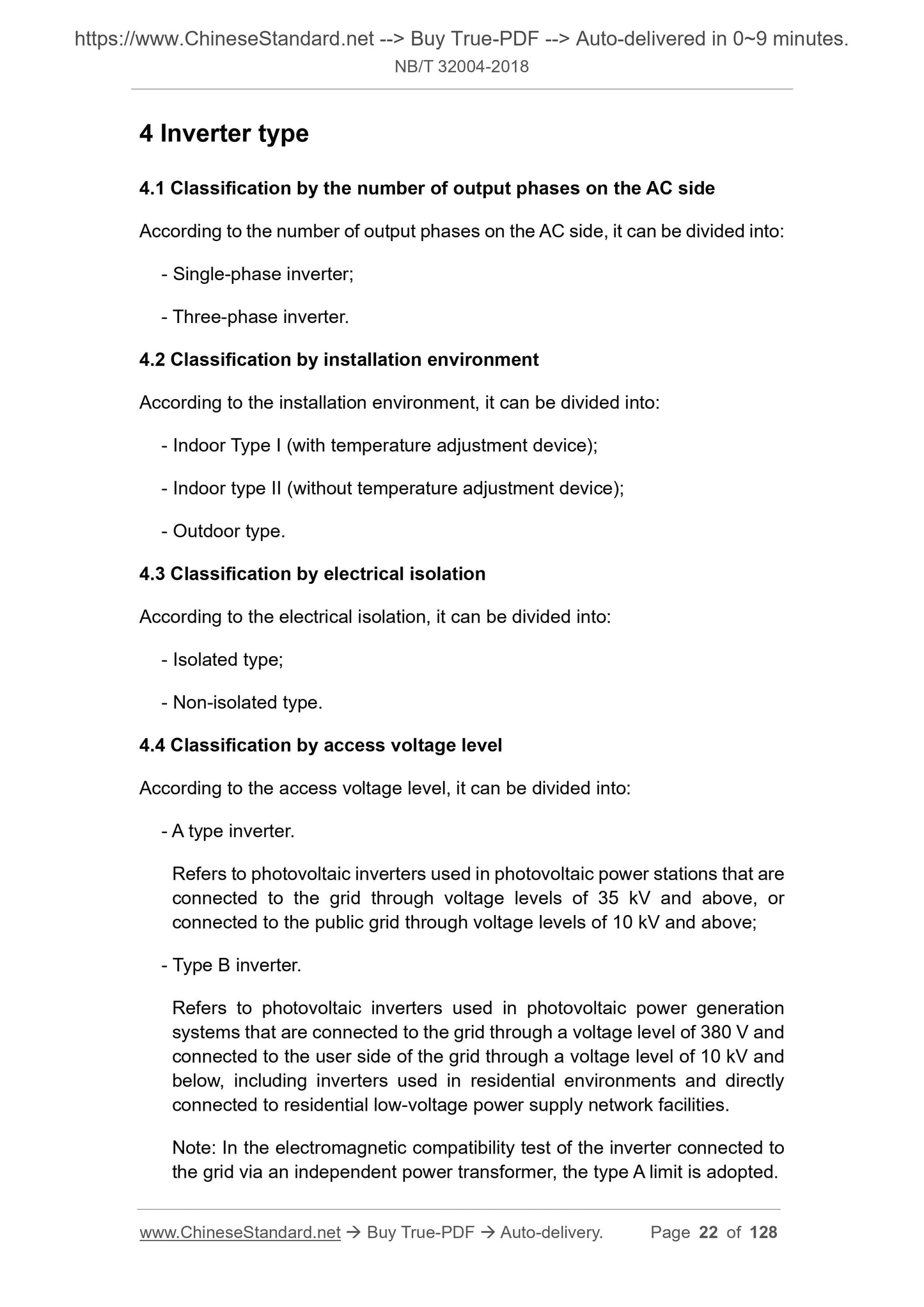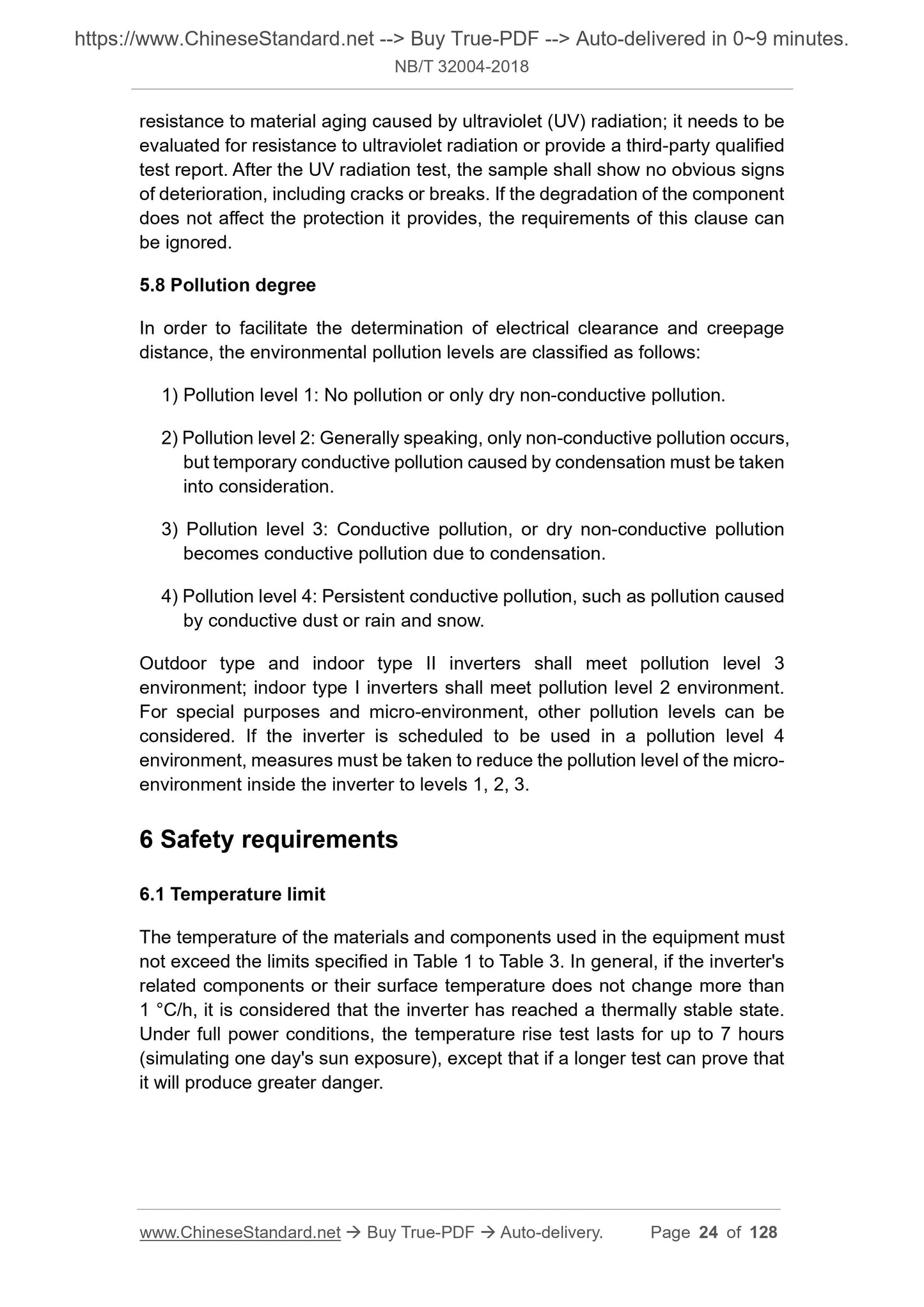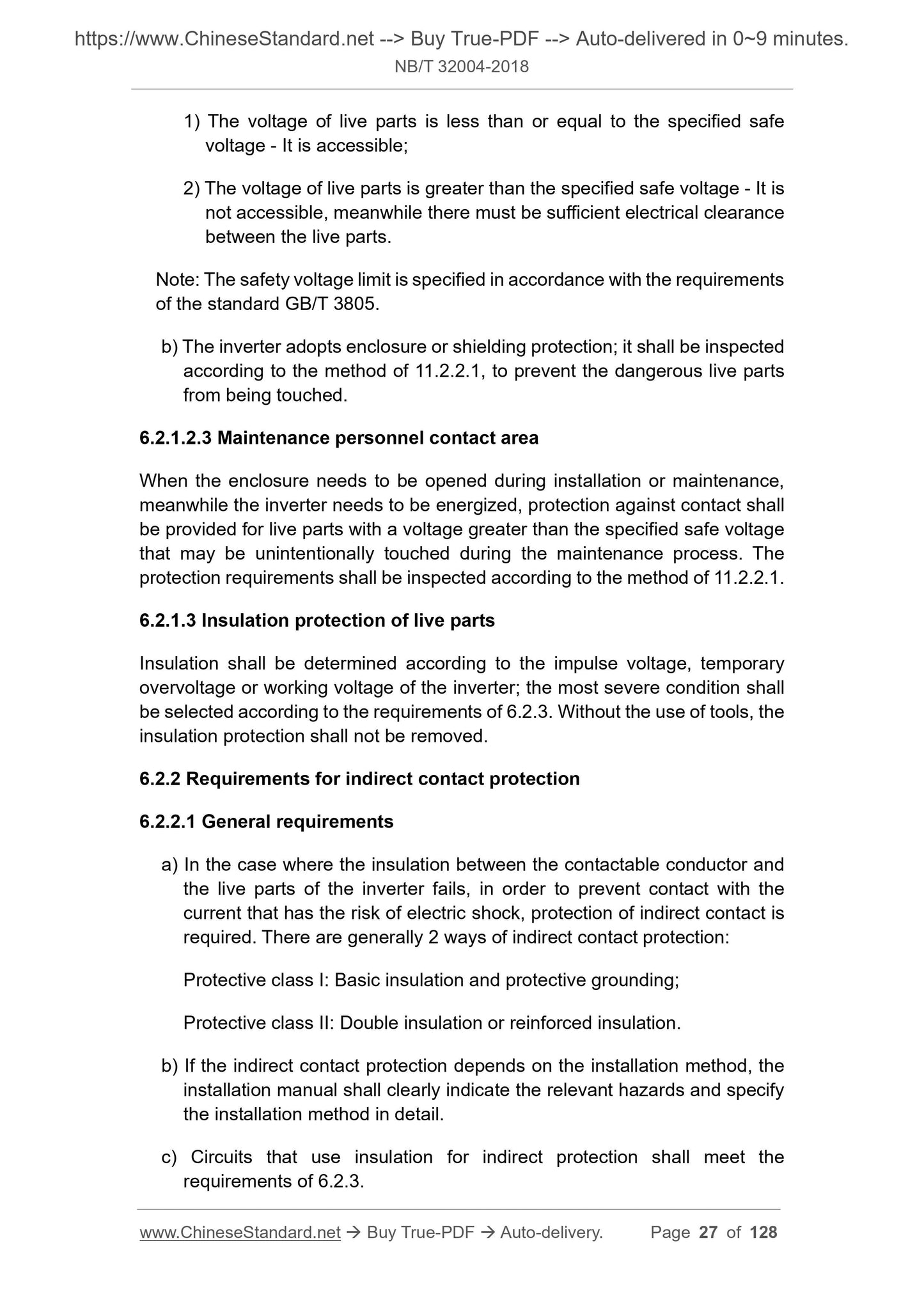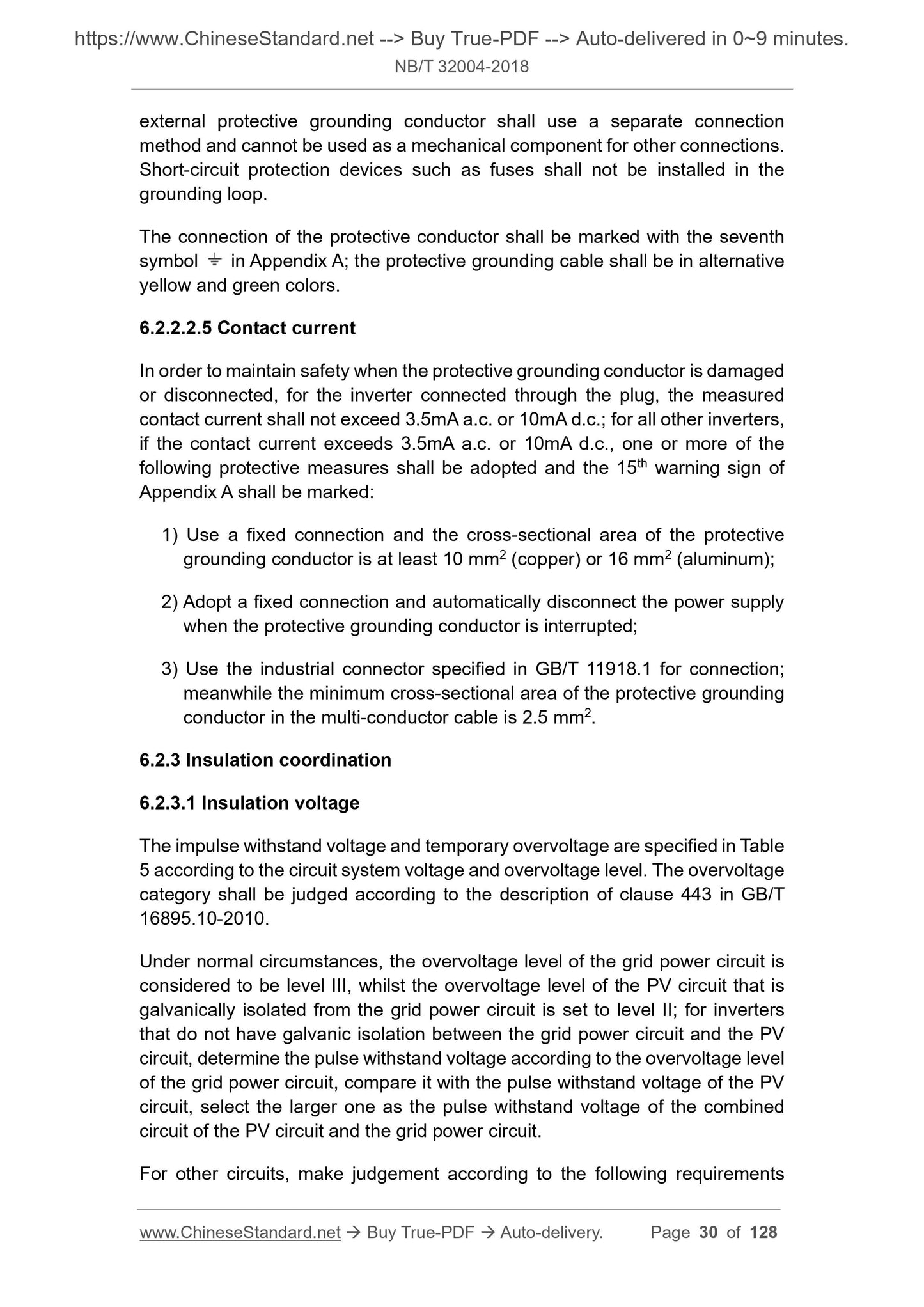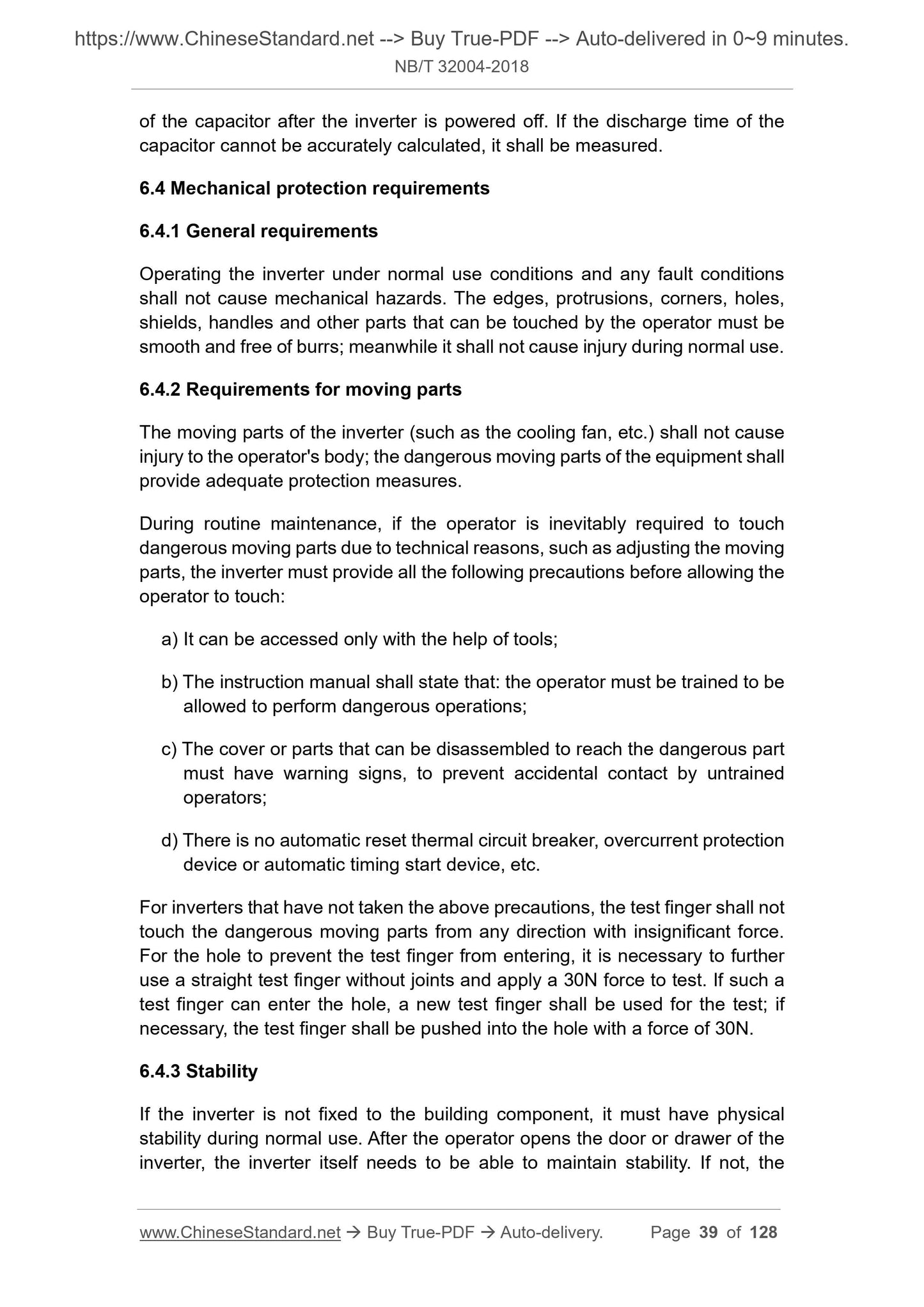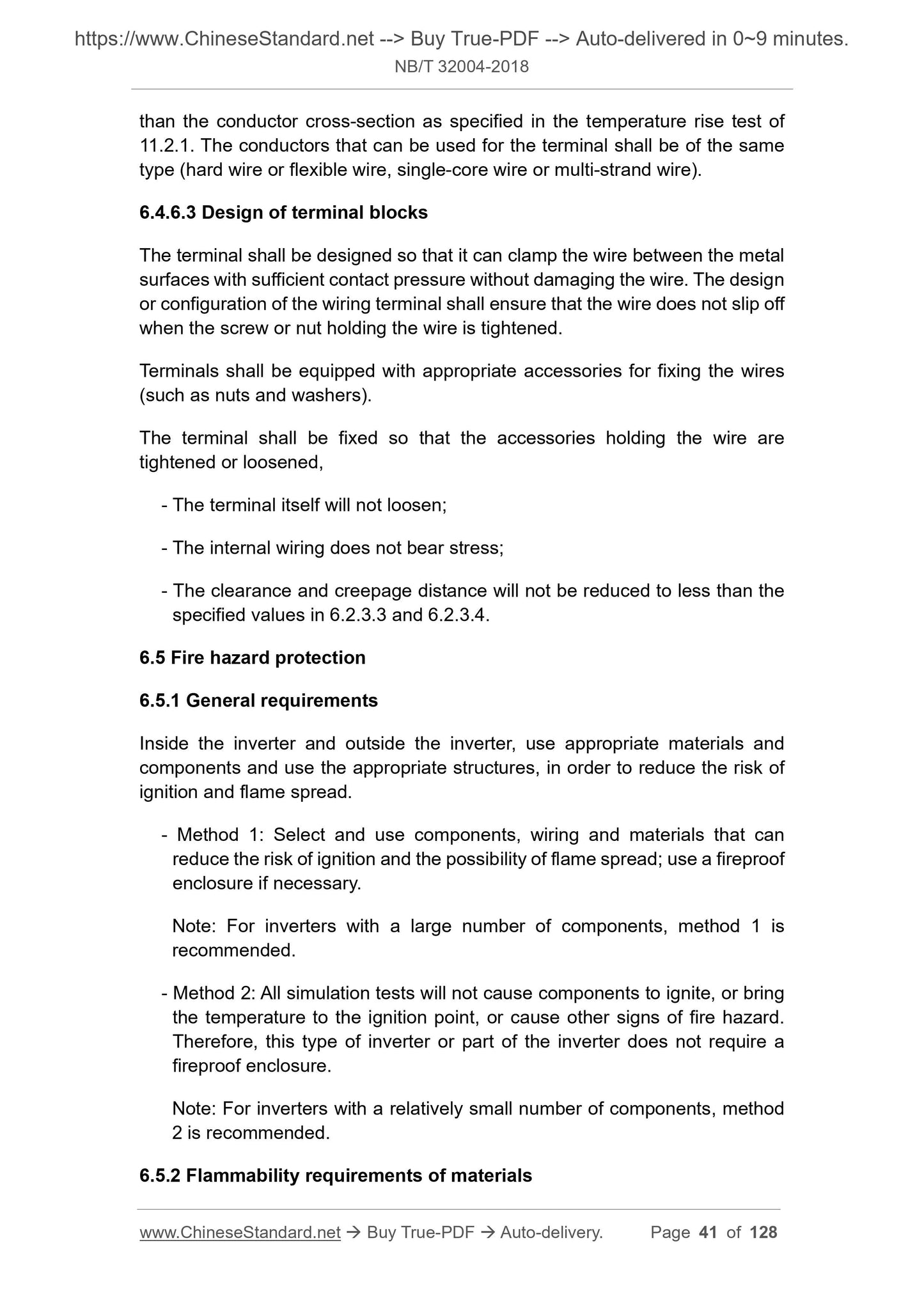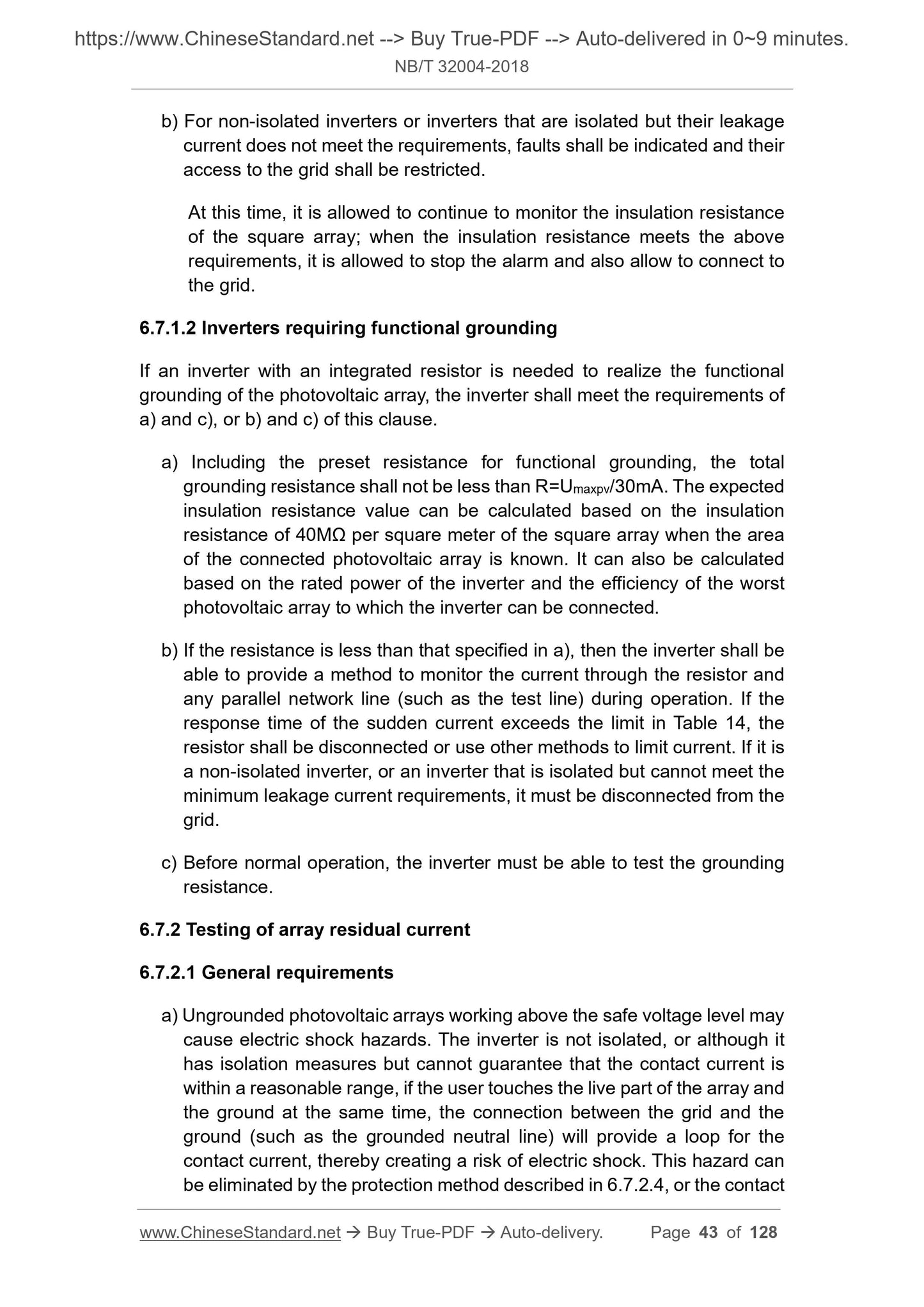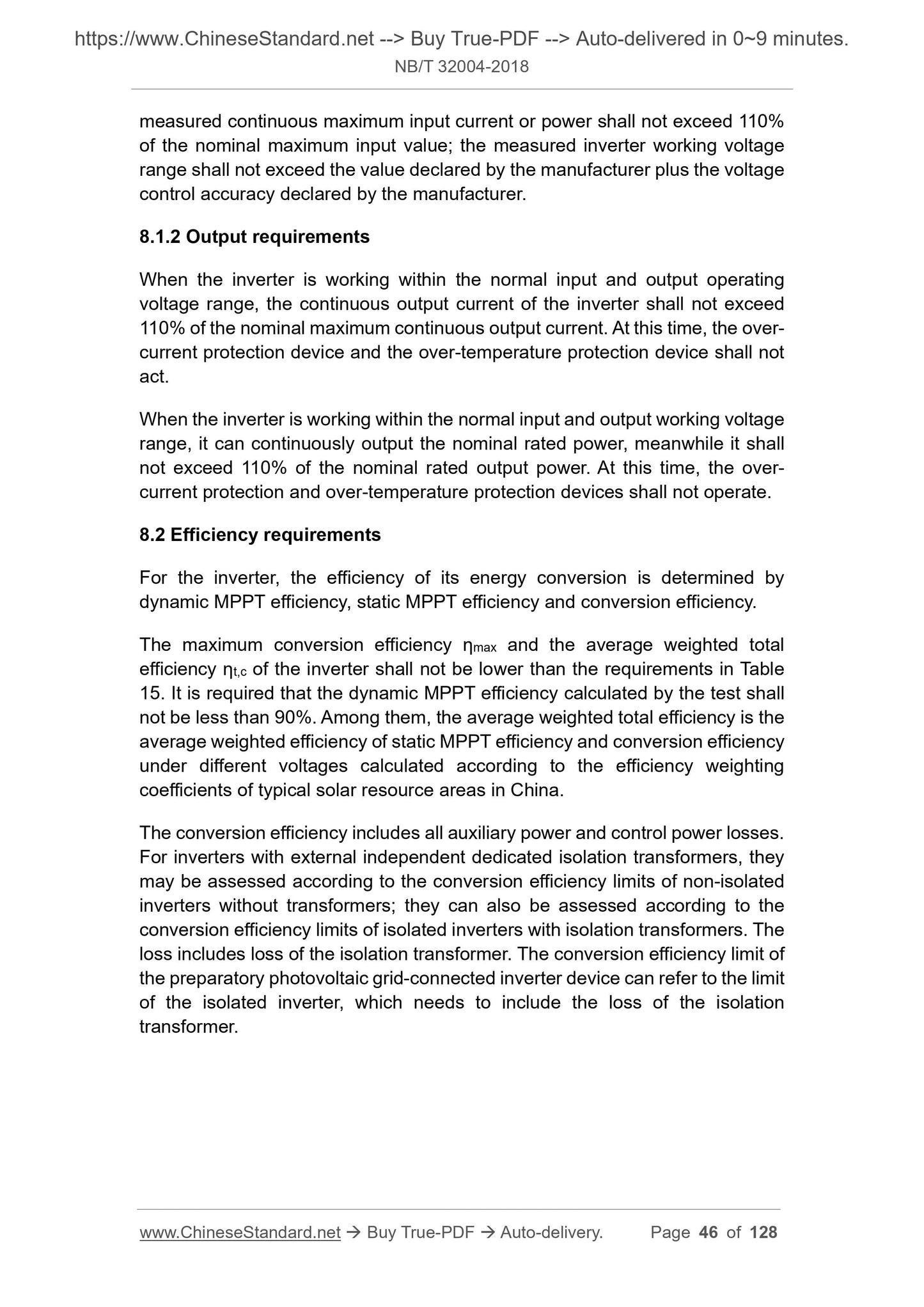1
/
of
12
PayPal, credit cards. Download editable-PDF and invoice in 1 second!
NB/T 32004-2018 English PDF (NBT32004-2018)
NB/T 32004-2018 English PDF (NBT32004-2018)
Regular price
$1,220.00 USD
Regular price
Sale price
$1,220.00 USD
Unit price
/
per
Shipping calculated at checkout.
Couldn't load pickup availability
Delivery: 3 seconds. Download true-PDF + Invoice.
Get QUOTATION in 1-minute: Click NB/T 32004-2018
Historical versions: NB/T 32004-2018
Preview True-PDF (Reload/Scroll if blank)
NB/T 32004-2018: Technical specification of PV grid-connected inverter
NB/T 32004-2018
NB
ENERGY INDUSTRY STANDARD OF
THE PEOPLE’S REPUBLIC OF CHINA
ICS 29.120.01
K 46
Filing number: 64298-2018
Replacing NB/T 32004-2013
Technical specification of PV grid-connected inverter
ISSUED ON: APRIL 03, 2018
IMPLEMENTED ON: JULY 01, 2018
Issued by: National Energy Administration
Table of Contents
Foreword ... 3
1 Scope ... 8
2 Normative references ... 8
3 Terms and definitions ... 11
4 Inverter type ... 22
5 Environmental and use requirements ... 23
6 Safety requirements ... 24
7 Basic functional requirements ... 45
8 Performance requirements ... 45
9 Protection requirements ... 62
10 Identification and documentation ... 65
11 Test method ... 70
12 Inspection rules ... 115
Appendix A (Normative) Symbols used on equipment identification ... 119
Appendix B (Normative) Humidity preconditioning ... 120
Appendix C (Informative) Measurement of inverter efficiency ... 121
References ... 128
Technical specification of PV grid-connected inverter
1 Scope
This standard specifies the product types, technical requirements and test
methods of photovoltaic grid-connected inverters used in photovoltaic (PV)
power generation systems.
This standard applies to photovoltaic grid-connected inverters connected to the
PV source circuit whose voltage does not exceed 1500V DC and whose AC
output voltage does not exceed 1000V. The preparatory photovoltaic inverter
where the integrated step-up transformer is grid-connected to the grid of 35kV
and below voltage level can refer to this standard.
2 Normative references
The following documents are essential to the application of this document. For
the dated documents, only the versions with the dates indicated are applicable
to this document; for the undated documents, only the latest version (including
all the amendments) are applicable to this standard.
GB/T 2423.1-2008 Environmental testing - Part 2: Test methods - Tests A:
Cold
GB/T 2423.2-2008 Environmental testing - Part 2: Test methods - Tests B:
Dry heat
GB/T 2423.3-2016 Environmental testing - Part 2: Testing method - Test Cab:
Damp heat, steady state
GB/T 2423.4-2008 Environmental testing for electric and electronic products
- Part 2: Test method - Test Db: Damp heat, cyclic ( 12h+12h cycle)
GB/T 2423.10-2008 Environmental testing for electric and electronic
products - Part 2: Tests methods - Test Fc: Vibration (sinusoidal)
GB/T 2828.1-2012 Sampling procedures for inspection by attributes - Part 1:
Sampling schemes indexed by acceptance quality limit (AQL) for lot-by-lot
inspection
GB/T 3805 Extra-low voltage (ELV) - Limit values
GB/T 16842-2016 Protection of persons and equipment by enclosures -
Probe for verification
GB 16895.3 Low-voltage electrical installations - Part 5-54: Selection and
erection of electrical equipment - Earthing arrangements and protective
conductors
GB/T 16895.10-2010 Low-voltage electrical installations - Part 4-44:
Protection for safety - Protection against voltage disturbances and
electromagnetic disturbances
GB 16895.21 Electrical installations of buildings - Part 4-41: Protection for
safety - Protection against electric shock
GB/T 16935.1-2008 Insulation coordination for equipment within low-voltage
systems - Part 1: Principles requirements and tests
GB/T 17626.2 Electromagnetic compatibility (EMC) - Testing and
measurement techniques - Electrostatic discharge immunity test
GB/T 17626.3 Electromagnetic compatibility- Testing and measurement
techniques - Radiated radio-frequency, electromagnetic field immunity test
GB/T 17626.4 Electromagnetic compatibility - testing and measurement
techniques - Electrical fast transient/burst immunity test
GB/T 17626.5 Electromagnetic compatibility - Testing and measurement
techniques - Surge immunity test
GB/T 17626.6 Electromagnetic compatibility - Testing and measurement
techniques - Immunity to conducted disturbances induced by radio-
frequency fields
GB/T 17626.8 Electromagnetic compatibility (EMC) - Part 8: Testing and
measurement techniques - Power frequency magnetic field immunity test
GB/T 17626.11 Electromagnetic compatibility - Testing and measurement
techniques - Voltage dips, short interruptions and voltage variations
immunity tests
GB/T 17626.12 Electromagnetic compatibility - Testing and measurement
techniques - Ring wave immunity test
GB/T 17626.18 Electromagnetic compatibility - Testing and measurement
techniques - Damped oscillatory wave immunity test
GB/T 17626.34 Electromagnetic compatibility - Testing and measurement
techniques - Voltage dips, short interruptions and voltage variations
4 Inverter type
4.1 Classification by the number of output phases on the AC side
According to the number of output phases on the AC side, it can be divided into:
- Single-phase inverter;
- Three-phase inverter.
4.2 Classification by installation environment
According to the installation environment, it can be divided into:
- Indoor Type I (with temperature adjustment device);
- Indoor type II (without temperature adjustment device);
- Outdoor type.
4.3 Classification by electrical isolation
According to the electrical isolation, it can be divided into:
- Isolated type;
- Non-isolated type.
4.4 Classification by access voltage level
According to the access voltage level, it can be divided into:
- A type inverter.
Refers to photovoltaic inverters used in photovoltaic power stations that are
connected to the grid through voltage levels of 35 kV and above, or
connected to the public grid through voltage levels of 10 kV and above;
- Type B inverter.
Refers to photovoltaic inverters used in photovoltaic power generation
systems that are connected to the grid through a voltage level of 380 V and
connected to the user side of the grid through a voltage level of 10 kV and
below, including inverters used in residential environments and directly
connected to residential low-voltage power supply network facilities.
Note: In the electromagnetic compatibility test of the inverter connected to
the grid via an independent power transformer, the type A limit is adopted.
resistance to material aging caused by ultraviolet (UV) radiation; it needs to be
evaluated for resistance to ultraviolet radiation or provide a third-party qualified
test report. After the UV radiation test, the sample shall show no obvious signs
of deterioration, including cracks or breaks. If the degradation of the component
does not affect the protection it provides, the requirements of this clause can
be ignored.
5.8 Pollution degree
In order to facilitate the determination of electrical clearance and creepage
distance, the environmental pollution levels are classified as follows:
1) Pollution level 1: No pollution or only dry non-conductive pollution.
2) Pollution level 2: Generally speaking, only non-conductive pollution occurs,
but temporary conductive pollution caused by condensation must be taken
into consideration.
3) Pollution level 3: Conductive pollution, or dry non-conductive pollution
becomes conductive pollution due to condensation.
4) Pollution level 4: Persistent conductive pollution, such as pollution caused
by conductive dust or rain and snow.
Outdoor type and indoor type II inverters shall meet pollution level 3
environment; indoor type I inverters shall meet pollution level 2 environment.
For special purposes...
Get QUOTATION in 1-minute: Click NB/T 32004-2018
Historical versions: NB/T 32004-2018
Preview True-PDF (Reload/Scroll if blank)
NB/T 32004-2018: Technical specification of PV grid-connected inverter
NB/T 32004-2018
NB
ENERGY INDUSTRY STANDARD OF
THE PEOPLE’S REPUBLIC OF CHINA
ICS 29.120.01
K 46
Filing number: 64298-2018
Replacing NB/T 32004-2013
Technical specification of PV grid-connected inverter
ISSUED ON: APRIL 03, 2018
IMPLEMENTED ON: JULY 01, 2018
Issued by: National Energy Administration
Table of Contents
Foreword ... 3
1 Scope ... 8
2 Normative references ... 8
3 Terms and definitions ... 11
4 Inverter type ... 22
5 Environmental and use requirements ... 23
6 Safety requirements ... 24
7 Basic functional requirements ... 45
8 Performance requirements ... 45
9 Protection requirements ... 62
10 Identification and documentation ... 65
11 Test method ... 70
12 Inspection rules ... 115
Appendix A (Normative) Symbols used on equipment identification ... 119
Appendix B (Normative) Humidity preconditioning ... 120
Appendix C (Informative) Measurement of inverter efficiency ... 121
References ... 128
Technical specification of PV grid-connected inverter
1 Scope
This standard specifies the product types, technical requirements and test
methods of photovoltaic grid-connected inverters used in photovoltaic (PV)
power generation systems.
This standard applies to photovoltaic grid-connected inverters connected to the
PV source circuit whose voltage does not exceed 1500V DC and whose AC
output voltage does not exceed 1000V. The preparatory photovoltaic inverter
where the integrated step-up transformer is grid-connected to the grid of 35kV
and below voltage level can refer to this standard.
2 Normative references
The following documents are essential to the application of this document. For
the dated documents, only the versions with the dates indicated are applicable
to this document; for the undated documents, only the latest version (including
all the amendments) are applicable to this standard.
GB/T 2423.1-2008 Environmental testing - Part 2: Test methods - Tests A:
Cold
GB/T 2423.2-2008 Environmental testing - Part 2: Test methods - Tests B:
Dry heat
GB/T 2423.3-2016 Environmental testing - Part 2: Testing method - Test Cab:
Damp heat, steady state
GB/T 2423.4-2008 Environmental testing for electric and electronic products
- Part 2: Test method - Test Db: Damp heat, cyclic ( 12h+12h cycle)
GB/T 2423.10-2008 Environmental testing for electric and electronic
products - Part 2: Tests methods - Test Fc: Vibration (sinusoidal)
GB/T 2828.1-2012 Sampling procedures for inspection by attributes - Part 1:
Sampling schemes indexed by acceptance quality limit (AQL) for lot-by-lot
inspection
GB/T 3805 Extra-low voltage (ELV) - Limit values
GB/T 16842-2016 Protection of persons and equipment by enclosures -
Probe for verification
GB 16895.3 Low-voltage electrical installations - Part 5-54: Selection and
erection of electrical equipment - Earthing arrangements and protective
conductors
GB/T 16895.10-2010 Low-voltage electrical installations - Part 4-44:
Protection for safety - Protection against voltage disturbances and
electromagnetic disturbances
GB 16895.21 Electrical installations of buildings - Part 4-41: Protection for
safety - Protection against electric shock
GB/T 16935.1-2008 Insulation coordination for equipment within low-voltage
systems - Part 1: Principles requirements and tests
GB/T 17626.2 Electromagnetic compatibility (EMC) - Testing and
measurement techniques - Electrostatic discharge immunity test
GB/T 17626.3 Electromagnetic compatibility- Testing and measurement
techniques - Radiated radio-frequency, electromagnetic field immunity test
GB/T 17626.4 Electromagnetic compatibility - testing and measurement
techniques - Electrical fast transient/burst immunity test
GB/T 17626.5 Electromagnetic compatibility - Testing and measurement
techniques - Surge immunity test
GB/T 17626.6 Electromagnetic compatibility - Testing and measurement
techniques - Immunity to conducted disturbances induced by radio-
frequency fields
GB/T 17626.8 Electromagnetic compatibility (EMC) - Part 8: Testing and
measurement techniques - Power frequency magnetic field immunity test
GB/T 17626.11 Electromagnetic compatibility - Testing and measurement
techniques - Voltage dips, short interruptions and voltage variations
immunity tests
GB/T 17626.12 Electromagnetic compatibility - Testing and measurement
techniques - Ring wave immunity test
GB/T 17626.18 Electromagnetic compatibility - Testing and measurement
techniques - Damped oscillatory wave immunity test
GB/T 17626.34 Electromagnetic compatibility - Testing and measurement
techniques - Voltage dips, short interruptions and voltage variations
4 Inverter type
4.1 Classification by the number of output phases on the AC side
According to the number of output phases on the AC side, it can be divided into:
- Single-phase inverter;
- Three-phase inverter.
4.2 Classification by installation environment
According to the installation environment, it can be divided into:
- Indoor Type I (with temperature adjustment device);
- Indoor type II (without temperature adjustment device);
- Outdoor type.
4.3 Classification by electrical isolation
According to the electrical isolation, it can be divided into:
- Isolated type;
- Non-isolated type.
4.4 Classification by access voltage level
According to the access voltage level, it can be divided into:
- A type inverter.
Refers to photovoltaic inverters used in photovoltaic power stations that are
connected to the grid through voltage levels of 35 kV and above, or
connected to the public grid through voltage levels of 10 kV and above;
- Type B inverter.
Refers to photovoltaic inverters used in photovoltaic power generation
systems that are connected to the grid through a voltage level of 380 V and
connected to the user side of the grid through a voltage level of 10 kV and
below, including inverters used in residential environments and directly
connected to residential low-voltage power supply network facilities.
Note: In the electromagnetic compatibility test of the inverter connected to
the grid via an independent power transformer, the type A limit is adopted.
resistance to material aging caused by ultraviolet (UV) radiation; it needs to be
evaluated for resistance to ultraviolet radiation or provide a third-party qualified
test report. After the UV radiation test, the sample shall show no obvious signs
of deterioration, including cracks or breaks. If the degradation of the component
does not affect the protection it provides, the requirements of this clause can
be ignored.
5.8 Pollution degree
In order to facilitate the determination of electrical clearance and creepage
distance, the environmental pollution levels are classified as follows:
1) Pollution level 1: No pollution or only dry non-conductive pollution.
2) Pollution level 2: Generally speaking, only non-conductive pollution occurs,
but temporary conductive pollution caused by condensation must be taken
into consideration.
3) Pollution level 3: Conductive pollution, or dry non-conductive pollution
becomes conductive pollution due to condensation.
4) Pollution level 4: Persistent conductive pollution, such as pollution caused
by conductive dust or rain and snow.
Outdoor type and indoor type II inverters shall meet pollution level 3
environment; indoor type I inverters shall meet pollution level 2 environment.
For special purposes...
Share
